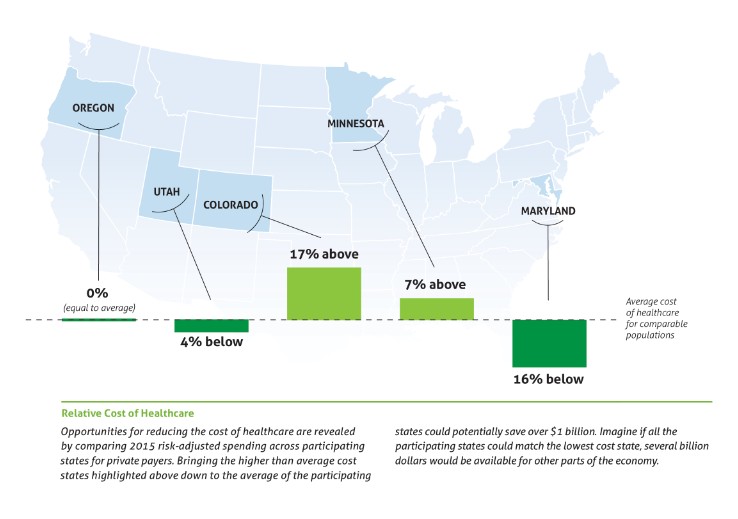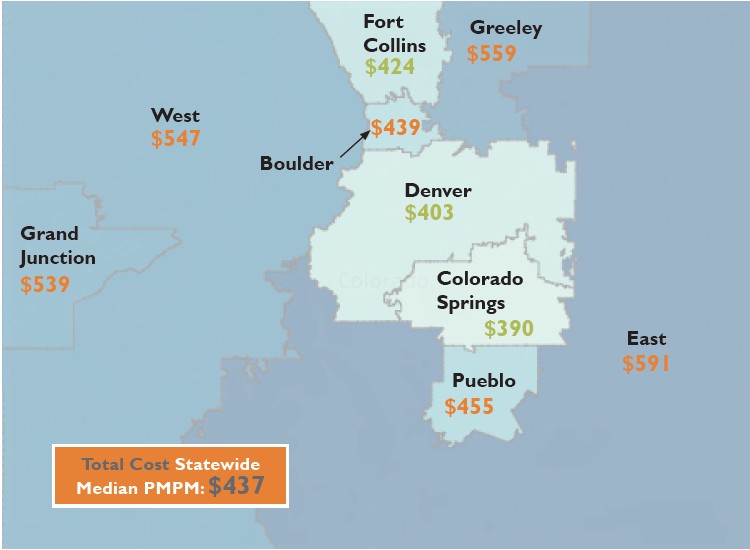How Big Is Colorado Compared To Other States, you might wonder? This question goes beyond mere geography, touching upon economic influence, population distribution, and even cultural impact. At COMPARE.EDU.VN, we delve into this comprehensive comparison, offering insights that will reshape how you perceive the Centennial State. Discover comparative insights, dimensional analysis, and scale perspective.
1. Understanding Colorado’s Size and Dimensions
To fully grasp how big Colorado is compared to other states, we need to examine its physical dimensions. Colorado is the 8th largest state in the United States, covering an area of approximately 104,094 square miles (269,601 square kilometers). This vast expanse includes the towering Rocky Mountains, arid deserts, and fertile plains.
1.1. Square Mileage Breakdown
- Total Area: 104,094 square miles
- Land Area: 103,642 square miles
- Water Area: 452 square miles
Colorado’s land area is substantial, making it a significant player in agriculture, natural resource extraction, and outdoor recreation.
1.2. Geographical Coordinates
- Latitude: Approximately 37° N to 41° N
- Longitude: Approximately 102° W to 109° W
These coordinates place Colorado in the Mountain West region, characterized by its rugged terrain and diverse ecosystems.
1.3. Comparing Colorado to Other Large States
When we ask, “How big is Colorado compared to other states?” it’s essential to see where it stands among the giants. Here’s a comparison with some of the largest states in the U.S.:
| State | Area (Square Miles) | Rank |
|---|---|---|
| Alaska | 665,384 | 1 |
| Texas | 268,596 | 2 |
| California | 163,696 | 3 |
| Montana | 147,040 | 4 |
| New Mexico | 121,590 | 5 |
| Arizona | 113,990 | 6 |
| Nevada | 110,572 | 7 |
| Colorado | 104,094 | 8 |
| Oregon | 98,379 | 9 |
| Wyoming | 97,814 | 10 |





As the table illustrates, Colorado is significantly smaller than Alaska and Texas, but it still holds a respectable position among the top ten largest states. This size influences everything from its climate to its economy.
2. How Colorado’s Size Affects Its Climate and Geography
The sheer size of Colorado plays a crucial role in shaping its diverse climate and geographical features. From the snow-capped peaks of the Rocky Mountains to the arid plains, Colorado’s varied landscape is a direct result of its expansive area.
2.1. Diverse Climate Zones
Colorado’s climate varies dramatically across its regions:
- Mountains: Alpine climate with cold winters and mild summers.
- Plains: Semi-arid climate with hot summers and cold winters.
- Desert Regions: Arid climate with significant temperature fluctuations.
This diversity is due to the state’s elevation changes and its location relative to major weather patterns.
2.2. Impact on Agriculture
The climate and geography influence the types of crops that can be grown. The eastern plains are suitable for wheat and corn, while the mountainous regions support livestock grazing.
2.3. Natural Resources
Colorado’s size and geological diversity mean it is rich in natural resources, including:
- Coal: Abundant reserves in the western part of the state.
- Oil and Gas: Significant production in the Denver-Julesburg Basin.
- Minerals: Deposits of gold, silver, and molybdenum.
The extraction and management of these resources are significant economic activities.
2.4. Tourism and Recreation
The state’s vast size and varied landscape make it a prime destination for tourism and outdoor recreation:
- Skiing and Snowboarding: World-class resorts in the Rocky Mountains.
- Hiking and Camping: Numerous trails in national parks and forests.
- Whitewater Rafting: Popular on the state’s many rivers.
These activities contribute significantly to Colorado’s economy.
3. Population Distribution in Colorado
Understanding how big Colorado is compared to other states also involves looking at its population distribution. Despite its large size, Colorado’s population is concentrated along the Front Range, where major cities like Denver, Boulder, and Colorado Springs are located.
3.1. Population Density
As of 2023, Colorado has a population of approximately 5.8 million people. However, the population density is relatively low compared to smaller states with larger populations.
- Overall Density: About 56 people per square mile.
- Front Range Density: Significantly higher due to urban concentration.
3.2. Major Metropolitan Areas
The Denver metropolitan area is the most populous region in Colorado, accounting for a significant portion of the state’s residents. Other major cities include:
- Colorado Springs: Located south of Denver, known for its military presence.
- Aurora: A large suburb of Denver, with a diverse population.
- Fort Collins: Home to Colorado State University, known for its research and technology sectors.
3.3. Rural vs. Urban Population
While the Front Range is heavily urbanized, large parts of Colorado remain rural:
- Rural Areas: Sparsely populated, with economies based on agriculture, ranching, and tourism.
- Urban Areas: Densely populated, with economies based on technology, finance, and services.
This dichotomy presents unique challenges and opportunities for the state’s development.
3.4. Impact on Infrastructure
The distribution of population affects the state’s infrastructure needs:
- Transportation: Major highways and airports are concentrated along the Front Range.
- Utilities: Energy and water resources must be distributed efficiently across the state.
- Services: Healthcare, education, and other services need to be accessible to both urban and rural residents.
4. Economic Comparison: Colorado vs. Other States
When examining “How big is Colorado compared to other states?” we must also consider its economic stature. Colorado’s economy is diverse, with significant contributions from technology, tourism, agriculture, and natural resources.
4.1. Gross Domestic Product (GDP)
As of 2022, Colorado’s GDP was approximately $450 billion, placing it among the top states in terms of economic output.
4.2. Key Industries
- Technology: A thriving tech sector in the Denver and Boulder areas.
- Tourism: A major source of revenue, driven by outdoor recreation and scenic attractions.
- Aerospace: A significant presence, with companies like Lockheed Martin and Boeing operating in the state.
- Agriculture: Important for the rural economy, with crops like wheat, corn, and hay.
- Natural Resources: Extraction of coal, oil, and gas.
4.3. Comparison with Other States
Here’s a comparison of Colorado’s GDP with other states:
| State | GDP (Billions USD) | Rank |
|---|---|---|
| California | 3,600 | 1 |
| Texas | 2,000 | 2 |
| New York | 1,900 | 3 |
| Florida | 1,200 | 4 |
| Illinois | 950 | 5 |
| Pennsylvania | 850 | 6 |
| Ohio | 800 | 7 |
| Georgia | 700 | 8 |
| Washington | 700 | 9 |
| New Jersey | 700 | 10 |
| Colorado | 450 | N/A |
Colorado’s economy is robust, but it is smaller than that of larger states like California and Texas. However, its per capita GDP is relatively high, reflecting a prosperous and well-educated workforce.
4.4. Employment Rates
Colorado has consistently maintained low unemployment rates compared to the national average. This is due in part to its diverse economy and skilled workforce.
4.5. Cost of Living
The cost of living in Colorado, particularly in the Denver metropolitan area, is higher than the national average. Housing costs are a significant factor, driven by strong demand and limited supply.
5. Cultural and Historical Significance
Beyond its physical and economic dimensions, Colorado holds significant cultural and historical importance. Understanding “How big is Colorado compared to other states?” also means recognizing its unique contributions to American culture and history.
5.1. Native American History
Colorado has a rich Native American history, with tribes such as the Ute, Cheyenne, and Arapaho inhabiting the region for thousands of years. Archaeological sites and cultural landmarks throughout the state offer insights into their way of life.
5.2. The Gold Rush
The discovery of gold in 1858 triggered a massive influx of settlers, transforming Colorado from a sparsely populated territory into a thriving state. Towns like Denver, Central City, and Black Hawk sprang up overnight, fueled by gold fever.
5.3. Western Heritage
Colorado retains a strong connection to its Western heritage, with ranching, rodeo, and cowboy culture still prevalent in many parts of the state.
5.4. Arts and Culture
Colorado boasts a vibrant arts and culture scene, with museums, theaters, and music venues throughout the state. Denver is home to the Denver Art Museum, the Denver Center for the Performing Arts, and numerous other cultural institutions.
5.5. Environmentalism
Colorado has a strong tradition of environmentalism, with a focus on protecting its natural resources and promoting sustainable practices. The state has been a leader in renewable energy and conservation efforts.
6. Political Landscape
The political landscape of Colorado is another important aspect when considering “How big is Colorado compared to other states?” Colorado has evolved from a historically conservative state to a more politically diverse and often progressive state.
6.1. Shifting Demographics
The influx of new residents, particularly to the Front Range, has changed the state’s demographics and political leanings. Urban areas tend to be more liberal, while rural areas remain more conservative.
6.2. Key Political Issues
- Environment: Protection of natural resources, climate change, and renewable energy.
- Healthcare: Access to affordable healthcare and insurance coverage.
- Education: Funding for public schools and higher education.
- Economy: Job growth, economic development, and income inequality.
6.3. Political Representation
Colorado is represented in the U.S. Congress by two senators and seven representatives. The state also has its own legislature, consisting of a Senate and a House of Representatives.
6.4. Voter Turnout
Colorado has consistently high voter turnout rates compared to other states. This reflects a strong civic engagement and a commitment to democratic participation.
7. Infrastructure and Transportation
Understanding “How big is Colorado compared to other states?” also involves looking at its infrastructure and transportation systems. Efficient transportation networks are essential for connecting the state’s diverse regions and supporting its economy.
7.1. Highways
Colorado has an extensive network of highways, including major interstates like I-25, I-70, and I-76. These highways facilitate the movement of goods and people across the state.
7.2. Airports
Denver International Airport (DIA) is one of the busiest airports in the world, serving as a major hub for domestic and international flights. Other regional airports provide air service to smaller communities.
7.3. Public Transportation
Public transportation options in Colorado include:
- RTD (Regional Transportation District): Provides bus and rail service in the Denver metropolitan area.
- Amtrak: Offers passenger rail service to select cities in Colorado.
- Local Bus Services: Available in many smaller communities.
7.4. Challenges and Opportunities
- Rural Transportation: Providing adequate transportation options in rural areas remains a challenge.
- Congestion: Traffic congestion in the Denver metropolitan area is a growing concern.
- Sustainability: Promoting sustainable transportation solutions, such as electric vehicles and public transit.
8. Education System
The education system in Colorado is a critical component of its overall development. Assessing “How big is Colorado compared to other states?” requires examining its educational infrastructure and performance.
8.1. Public Schools
Colorado has a network of public schools, including elementary, middle, and high schools. Funding for public education comes from a combination of state and local sources.
8.2. Higher Education
Colorado is home to several prominent universities and colleges, including:
- University of Colorado Boulder: A leading research university with a strong focus on science and engineering.
- Colorado State University: Known for its programs in agriculture, natural resources, and veterinary medicine.
- University of Denver: A private university with a strong emphasis on business and law.
- Colorado School of Mines: A renowned engineering school specializing in mineral resources and energy.
8.3. Educational Attainment
Colorado has a highly educated population, with a large percentage of residents holding bachelor’s degrees or higher. This is a significant factor in attracting high-tech industries and driving economic growth.
8.4. Challenges and Opportunities
- Funding Disparities: Addressing funding disparities between wealthy and poor school districts.
- Teacher Shortages: Recruiting and retaining qualified teachers, particularly in rural areas.
- College Affordability: Ensuring that higher education is accessible and affordable for all residents.
9. Healthcare System
Examining the healthcare system is essential when answering “How big is Colorado compared to other states?” Access to quality healthcare is a key indicator of a state’s well-being and overall quality of life.
9.1. Healthcare Providers
Colorado has a network of hospitals, clinics, and healthcare providers throughout the state. Major healthcare systems include:
- UCHealth: A large academic medical center affiliated with the University of Colorado.
- Centura Health: A faith-based healthcare system with hospitals and clinics across the state.
- Kaiser Permanente: An integrated healthcare system with a strong presence in the Denver metropolitan area.
9.2. Health Insurance Coverage
Colorado has made progress in reducing the number of uninsured residents, but challenges remain, particularly among low-income individuals and families.
9.3. Public Health Initiatives
The Colorado Department of Public Health and Environment (CDPHE) leads public health initiatives aimed at preventing disease, promoting wellness, and protecting the environment.
9.4. Healthcare Costs
Healthcare costs in Colorado are relatively high compared to other states. Factors contributing to these high costs include:
- High Prices for Services: The cost of medical procedures and prescription drugs.
- High Utilization Rates: The frequency with which people use healthcare services.
- Administrative Overhead: The cost of managing healthcare systems.
9.5. Addressing Healthcare Challenges
Colorado is actively working to address healthcare challenges through initiatives such as:
- Expanding Access to Coverage: Increasing the availability of affordable health insurance.
- Promoting Preventive Care: Encouraging people to take steps to prevent disease and stay healthy.
- Controlling Healthcare Costs: Implementing measures to reduce the cost of medical services.
10. Conclusion: Colorado’s Place Among the States
So, how big is Colorado compared to other states? It’s clear that Colorado’s significance extends far beyond its geographical size. Its diverse economy, rich cultural heritage, and strategic location in the Mountain West make it a key player in the United States. From its towering peaks to its thriving urban centers, Colorado offers a unique blend of natural beauty and economic opportunity.
10.1. Key Takeaways
- Size Matters: Colorado’s large size influences its climate, geography, and resource base.
- Economic Powerhouse: Colorado’s diverse economy is driven by technology, tourism, agriculture, and natural resources.
- Cultural Richness: Colorado’s history and culture are shaped by its Native American heritage, the Gold Rush, and its Western traditions.
- Political Influence: Colorado’s political landscape is evolving, with increasing diversity and engagement.
- Infrastructure and Education: Colorado’s transportation networks and education system are critical to its continued growth and prosperity.
- Healthcare Challenges: Colorado faces ongoing challenges in ensuring access to affordable, high-quality healthcare.
10.2. The Future of Colorado
As Colorado continues to grow and evolve, it will face new challenges and opportunities. Addressing issues such as population growth, climate change, and economic inequality will be essential to ensuring a sustainable and prosperous future for the state.
Whether you’re comparing states for relocation, investment, or simply curiosity, COMPARE.EDU.VN offers comprehensive insights to inform your decisions. Explore detailed comparisons of economic indicators, quality of life, and more. Make your next decision with confidence.
Ready to explore further? Visit COMPARE.EDU.VN today for detailed comparisons and insights. Our comprehensive analyses will help you make informed decisions, whether you’re comparing schools, services, or products. Don’t navigate the complexities alone—let COMPARE.EDU.VN be your trusted guide.
Our team at COMPARE.EDU.VN is dedicated to providing objective and comprehensive comparisons to help you make informed decisions. For more information, visit our website or contact us at:
Address: 333 Comparison Plaza, Choice City, CA 90210, United States
WhatsApp: +1 (626) 555-9090
Website: compare.edu.vn
FAQ: Colorado Compared to Other States
1. How does Colorado’s land area compare to other states?
Colorado’s land area is approximately 104,094 square miles, making it the 8th largest state in the U.S. It is smaller than Alaska, Texas, and California, but larger than states like Oregon and Wyoming.
2. What are the main factors driving Colorado’s economy?
Colorado’s economy is driven by technology, tourism, aerospace, agriculture, and natural resources. The Denver and Boulder areas have a thriving tech sector, while tourism is boosted by the state’s outdoor recreation opportunities.
3. How does Colorado’s population density compare to other states?
Colorado has a relatively low population density of about 56 people per square mile. The population is concentrated along the Front Range, where major cities like Denver, Boulder, and Colorado Springs are located.
4. What are the major transportation hubs in Colorado?
Denver International Airport (DIA) is a major transportation hub, serving as a key airport for domestic and international flights. Additionally, the state has an extensive network of highways, including I-25, I-70, and I-76.
5. How does the cost of living in Colorado compare to other states?
The cost of living in Colorado, particularly in the Denver metropolitan area, is higher than the national average. Housing costs are a significant factor due to strong demand and limited supply.
6. What are some of the key political issues in Colorado?
Key political issues in Colorado include environment protection, healthcare access, education funding, and economic development. The state has become more politically diverse in recent years.
7. What are some of the top universities and colleges in Colorado?
Colorado is home to several prominent universities, including the University of Colorado Boulder, Colorado State University, University of Denver, and Colorado School of Mines.
8. How is Colorado addressing healthcare challenges?
Colorado is addressing healthcare challenges by expanding access to coverage, promoting preventive care, and implementing measures to control healthcare costs.
9. What is Colorado’s role in renewable energy?
Colorado has been a leader in renewable energy and conservation efforts. The state has set ambitious goals for reducing greenhouse gas emissions and increasing the use of renewable energy sources.
10. What are some of the cultural attractions in Colorado?
Colorado boasts a vibrant arts and culture scene, with museums, theaters, and music venues throughout the state. Denver is home to the Denver Art Museum and the Denver Center for the Performing Arts, among other cultural institutions.

